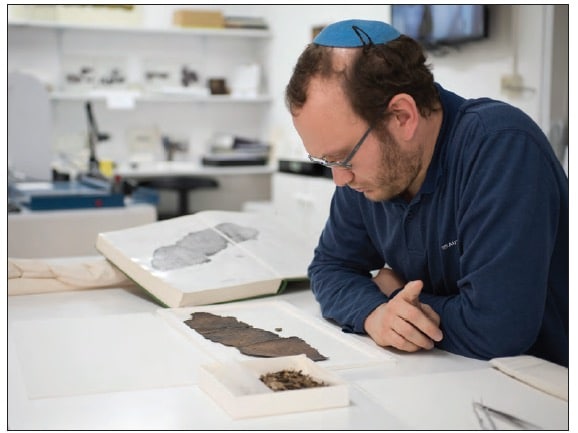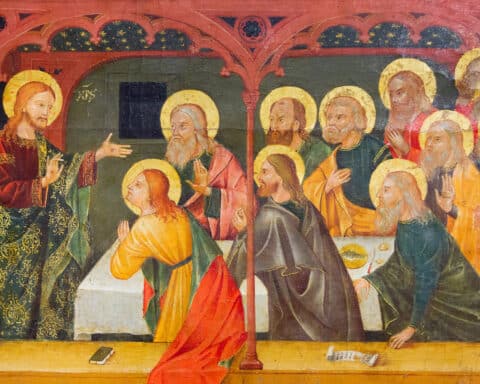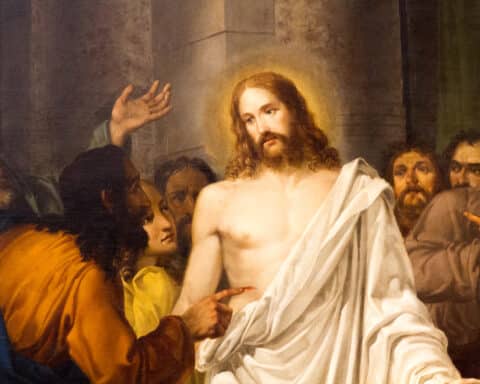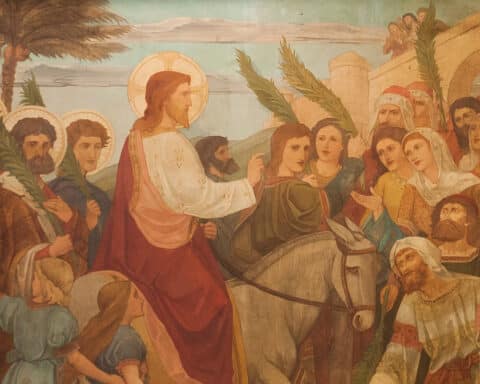Doctoral student Oren Ableman couldn’t believe his eyes.
The Hebrew University student and scroll researcher at the Dead Sea Scrolls Unit of the Israel Antiquities Authority (IAA) had been working on a digitization project for the Dead Sea Scrolls, going through thousands of fragments of the manuscripts when he began to notice something unique about them. Initially using a microscope and infrared lighting, he saw there were traces of ink on many of the fragments that appeared blank to the naked eye.
“I could immediately see that they had images on them,” said Ableman. “The very first fragment I took out, I saw something but couldn’t make out the writing under the microscope. I knew there may be something there but was surprised as to how much there was.”
New tech, new evidence
Working in conjunction with conservators at the Dead Sea Scrolls Project of the IAA at the Israel Museum under the supervision of Professor Esther Chazon, director of Hebrew University’s Orion Center for the Study of the Dead Sea Scrolls, Ableman’s work quickly developed from one of conservation to one with a greater and unexpected scope.
Much of the material he was investigating came from boxes of scroll fragments that had been stored for safekeeping decades earlier at the Dominican Ecole Biblique in Jerusalem because of their small size and precarious physical state. Until 1991, the group of Dead Sea Scroll scholars had been kept insular, with eight Ecole Biblique scholars retaining the publishing rights, so only a few fragments had been published. At that point the IAA opened the research to other scholars, and within a decade 40 more volumes were published.
But now Ableman has uncovered new evidence, 70 years after the first discovery of the scrolls.
Eventually the researchers turned to multi-spectral imaging, using a NASA-inspired space-age technology to study the oldest Biblical texts dating back more than 2,000 years ago, said Pnina Shor, curator and head of the Dead Sea Scrolls projects of the Israel Antiquities Authority. With the help of NASA consultant Dr. Greg Bearman, they adapted the MRI technology he had developed to the Dead Sea Scrolls project research.
In the multi-year, multi-million-dollar project, a special room was set up at their labs for an enormous MRI computerized camera. The 12-wave imaging creates a full, three-dimensional digitalized likeness of the fragments. The different light spectrums reveal text hidden under darkened patches on the parchment, invisible to the naked eye. The images will be publicly available on the IAA Dead Sea Scroll project website.
“I had better access to better imaging techniques [than the original researchers had] which is now available,” said Ableman. “And I had access to a computerized database with texts of the Dead Sea Scrolls and the Hebrew Bible. It was very exciting to see something for the first time and be able to recognize it and read it.”
Ableman started with 82 fragments that had been found in the 11th, and last, cave. Out of those, he found hidden text on 12, which he was able to connect to other manuscripts or known texts.
Unknown manuscripts
In the 1950s the only imaging available to researchers was infrared lighting. Today multi-spectral imagery provides stronger imaging possibilities and allows for enlarging an image, looking at contrast and cutting and pasting, she said.
“By applying both modern computer techniques and photography images, we are able to read parts of words that were there before but we were not able to read,” Chazon said. “It has added new pieces of information and given us the ability to verify things that in the past were hypothetical.”
Using the new imaging technology, Ableman was able to identify fragments from the Books of Deuteronomy, Leviticus and Jubilees belonging to scrolls that scholars are already familiar with. Fragments were also found providing new insights to the Dead Sea Scrolls research, including a fragment belonging to the Temple Scroll, which gives directions for conducting services at the ideal temple. The identification of new fragments strengthens the theory that there is a third copy of this text from Cave 11.
In addition, another fragment has been identified as belonging to the Great Psalms Scroll, preserving the beginning of Psalm 147:1. The new fragment indicates that the text of this psalm in this manuscript was slightly shorter than the Hebrew text commonly used nowadays.
“As an orthodox Jew, this specific psalm is part of our daily prayer … so I am very familiar with it, and when I saw it I knew it was a slightly different version,” said Ableman.
A third fragment contains letters written in the ancient paleo-Hebrew script and cannot be attributed to any of the known manuscripts. This raises the possibility that it belonged to an, until now, unknown manuscript.
History of the scrolls
The first Dead Sea Scroll was discovered by a Bedouin shepherd in 1947. A Hollywood-worthy race then ensued as archaeologists rushed to uncover other scrolls before the caves were plundered and sold by Bedouin looters. More scrolls were discovered in the late 1940s and early ’50s in a series of 11 caves located near Qumran in the Judean Desert. They uncovered tens of thousands of parchment pieces and papyrus fragments belonging to 1,000 different manuscripts handwritten at the end of the second century at the intersection of Judaism and Christianity.
Some scholars believe that John the Baptist may have been a part of the Essene community, which is believed to have written many of the scrolls, and that Jesus was influenced by the community as well.
Among the scrolls are the Nachum Scroll; the Temple Scroll, which was written while the Second Temple was still standing; and the Scroll of the Sons of Light and the Sons of Dark. Papyrus texts from the Persian, Byzantine and Islamic period have also been found in the 11 caves.
“These are the earliest copies of Biblical text other than the Book of Esther, so they are important for Biblical research,” Shor said. “There are also other Jewish texts which disappeared after the destruction of the Second Temple and other outside texts. The one who preserved the texts was the Church who had it translated from Greek, then to Latin and then back to Hebrew. It is interesting to compare this now — in its original Hebrew and Aramaic.”
Many of these scrolls’ physical states had been unknowingly compromised by the early researchers, who had little access to knowledge about conservation of such antiquities, so the current conservation imaging project is of urgent importance.
The fragments were presented to the public in January.
“It is amazing how new technology is helping us to discover our past,” said Ableman. “One of the results is that scholars have started to review their own concepts. With the help of this new imaging, we are making new discoveries about texts we have studied before. I always thought those [early] scholars were really lucky they were able to read through text nobody had read in 2,000 years. I am part of the younger generation of scholars, and even though my discovery is small compared to the original discovery, it is very exciting to feel that I am following the footsteps of scholars I always admired.”
Judith Sudilovsky writes from Jerusalem.





